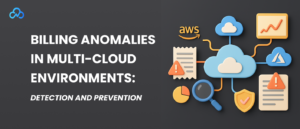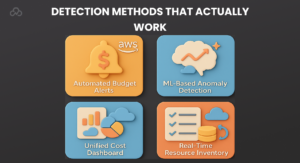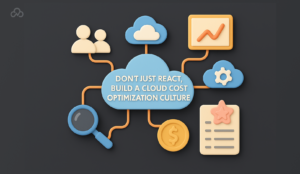Billing Anomalies in Multi-Cloud Environments: Detection and Prevention

If you’ve ever opened your cloud billing dashboard and muttered, “That can’t be right,” you’re not alone. Operating across AWS, Azure, GCP, what was supposed to be a smart move toward resilience and flexibility, can quietly become a budgetary nightmare. One service misconfigured, one resource left running, and suddenly your spend has tripled overnight. These unexpected cost jumps? They’re not bugs, They’re billing anomalies, and in a multi-cloud setup, they’re not just common ,They’re inevitable if you’re not paying attention. The solution isn’t to pull back from cloud, but to get smarter with how you manage it. That’s where cloud cost optimization best practices come in. Think proactive alerting, strict tagging, predictive analytics, and governance that’s baked into your DevOps flow. The stakes? Controlling costs before they spiral.
Whether you’re a scaling startup or a legacy enterprise in the middle of cloud transformation while practicing cloud cost optimization best practices, tackling this head-on with the right cloud cost optimization tools and internal workflows could mean the difference between sustainable growth, or a CFO breathing down your neck.
What Causes Billing Anomalies in Multi-Cloud Setups?
To fix billing issues, you first need to understand what’s causing them, and in multi-cloud environments, that’s often easier said than done.
Here’s where it usually goes wrong:
-
A team spins up a test environment, and forgets to shut it down.
-
Auto-scaling kicks in during a usage spike but never scales back down.
-
Someone duplicates services across AWS and Azure “just to be safe”, without realizing both are running 24/7.
-
Storage or data transfer quietly grows over time, and no one’s tracking it.
-
Worse, shadow IT creeps in, resources get deployed without oversight, tagging, or approval.
In a single-cloud setup, these issues are manageable. But in multi-cloud? Everything’s fragmented. Different cost structures, Different reporting cadences, Different formats. That makes billing anomalies not just harder to catch, but harder to explain when they do happen.
The Cost of Not Knowing
Here’s the hard truth: most teams don’t notice billing anomalies until the numbers are already painful.
According to Flexera’s State of the Cloud report, companies are wasting around 32% of their cloud spend simply due to poor visibility and management. And with workloads spread across AWS, Azure, and GCP, even a single misstep can turn into a five- or six-figure surprise before finance catches it.
Real-World Case:
One fintech company noticed a sharp $45,000 spike in its cloud bill. Panic set in. After digging around, they found the culprit: a dev team had launched a GPU-heavy instance in Azure, for a quick model test. But they forgot to shut it down. It ran around the clock in production for weeks, completely untracked.
Detection Methods That Actually Work

Spotting anomalies in real time requires more than just logging into the billing dashboard once a month. Here’s what modern cloud teams that adopt cloud cost optimization best practices are doing:
1. Automated Budget Alerts and Thresholds
Set hard and soft spending limits by project, region, or service. Use cloud-native tools like AWS Budgets, Azure Cost Management, or GCP Billing Alerts.
2. Time-Series Analysis and Machine Learning
Anomaly detection models trained on historical billing data can identify outliers. Platforms like Anodot or Harness use AI to detect deviations in real time.
3. Unified Cost Dashboards
Deploy cloud cost optimization tools that aggregate multi-cloud data. CloudHealth and Apptio Cloudability provide consolidated insights with built-in alerting.
4. Real-Time Resource Inventory
Use infrastructure-as-code (IaC) to tie all deployed assets to version-controlled configuration. If something changes, you’ll know.
Prevention Through Cloud Cost Optimization Best Practices
Enforce Tagging and Labeling Policies
Make resource tagging mandatory across all clouds. Label by team, function, environment (dev/prod), and cost center.
Centralize Governance
Use a FinOps approach, combine finance, DevOps, and cloud architects in a cost steering team. Create budgets and enforce them.
Use Scheduling for Non-Prod Environments
Automatically shut down idle dev/test environments outside working hours. Tools like Terraform and Cloud Custodian help.
Adopt Reserved Instances and Spot Pricing
Lock in discounts for predictable workloads and use spot instances for interruptible tasks.
Run Regular Cloud Cost Optimization Assessments
Review historical data every quarter. Identify waste, optimize configurations, and forecast based on usage patterns.
Latest Trends: AI-Driven Billing Optimization
AI is playing a bigger role in cloud cost optimization strategies. New tools don’t just report costs, they suggest savings opportunities and even auto-correct over provisioned resources.
For example, Google Cloud Recommender and Azure Advisor now offer actionable cost-saving insights powered by AI. These suggestions include rightsizing VMs, terminating unused resources, and adjusting reserved instance plans.
Sample Comparison Table:
|
Feature |
Traditional Monitoring |
AI-Powered Optimization |
|
Manual Review Needed |
✅ |
❌ |
|
Detects Root Causes |
❌ |
✅ |
|
Auto-Fixes Issues |
❌ |
✅ (in some platforms) |
|
Multi-Cloud Compatibility |
⚠️ Limited |
✅ |
Real-World Insights: What Cloud Cost Optimization Companies Are Seeing
Leading cloud cost optimization companies that practice cloud cost optimization best practices consistently report that a lack of visibility is the root cause of most anomalies, not reckless spending. In multi-cloud setups, teams often assume someone else is monitoring usage. But with resources scattered across platforms and environments, gaps quickly form.
Example:
A retail company with workloads on both AWS and Google Cloud discovered they were running redundant containerized services in both environments. No one noticed because the teams were siloed. After a third-party cloud cost optimization assessment, they cut redundant spend by over 38% in three months.
This is where external experts add real value. By using industry-leading cloud cost optimization tools and frameworks, these companies don’t just flag issues, they benchmark your usage, suggest actionable changes, and help implement policy-based controls that prevent future overspending. All with the help of cloud cost optimization best practices.
Cloud Cost Optimization Tools Worth Exploring in 2025
While every cloud provider offers native tools, modern teams rely on third-party platforms to consolidate data and give richer insights. Here are a few worth highlighting:
|
Tool |
Best For |
Cloud Compatibility |
|
CloudHealth |
Enterprise-level cost visibility and reporting |
AWS, Azure, GCP |
|
Apptio Cloudability |
FinOps adoption and detailed budgeting |
Multi-cloud |
|
Spot by NetApp |
Auto-optimization of compute resources |
AWS, Azure |
|
Kubecost |
Kubernetes cost tracking at pod/service level |
Kubernetes, EKS, AKS, GKE |
These tools help reinforce cloud cost optimization best practices by automating monitoring, forecasting, and even remediation in some cases.
Bonus Tip: Pair these tools with open-source frameworks like Cloud Custodian or Infracost for added customization and IaC integration.
Why a Cloud Cost Optimization Assessment Should Be Part of Your Roadmap
Still treating cost reviews as an afterthought? Then you’re almost guaranteed to lose money over time.
A structured cloud cost optimization assessment takes a deeper look at how your organization is using cloud resources. This usually includes:
-
A historical usage analysis
-
Workload rightsizing recommendations
-
Forecasting based on expected scaling
-
Policy compliance checks (e.g. tagging enforcement, idle cleanup)
-
Cross-cloud comparison and cost per team/project
Many cloud cost optimization companies that practice cloud cost optimization best practices offer assessments as part of onboarding. Even if you manage your own environment, performing these evaluations quarterly ensures you stay on track, and don’t fall back into wasteful habits.
Trending Now: Policy-as-Code Meets Cost Governance
Cloud cost optimization strategies are evolving. One of the strongest trends in 2025 is integrating policy-as-code to enforce cost controls automatically.
For instance, you can write a policy that automatically terminates EC2 instances tagged “dev” if idle for more than 24 hours. Or prevent developers from launching GPU instances unless authorized by a specific IAM role.
This is a major leap from the manual policing of resources. Now, teams can codify cost controls the same way they manage security or compliance, scalable, automated, and audit-friendly.
Table: Sample Policy-as-Code Rules for Cost Control
|
Policy Objective |
Rule Example |
|
Idle resource termination |
Shut down non-prod VMs after 8PM |
|
Restrict high-cost instance use |
Block p3 GPU instance creation unless labeled “approved” |
|
Enforce tagging |
Deny deployment of any untagged storage buckets |
|
Budget guardrails |
Alert or block spend over $X per team/project/month |
These policies are often implemented using tools like Cloud Custodian, OPA (Open Policy Agent), or even custom Lambda functions triggered by CloudTrail logs.
Don’t Just React, Build a Cloud Cost Optimization Culture

Here’s what often gets overlooked: cloud cost optimization isn’t just about using the latest tools, it’s about mindset. You can invest in dashboards and automation all day, but if your teams aren’t thinking about cost the same way they think about performance or uptime, you’ll keep bleeding money in the background.
What actually works? Shifting how your engineers, architects, and finance teams talk about cloud. Make cost a shared responsibility. Put spending metrics right next to latency and error rates. Highlight cost trends during sprint reviews, not just once a quarter when the invoice drops.
Even better, reward cost-aware behavior. When teams ship something leaner, smarter, and cheaper? Call it out. Because the most effective cloud cost optimization strategies aren’t just cross-functional, they’re cultural. And once that takes root, the savings tend to follow.
Technical FAQs
Q1: How can I spot billing anomalies early, before they spiral?
Don’t wait for the end-of-month invoice. Set up automated alerts that trigger when costs exceed normal thresholds, and use anomaly detection powered by historical billing data. Think of it like setting a smoke alarm before there’s even smoke.
Q2: What cloud cost optimization tools actually help in multi-cloud setups?
You’ll want tools that give you a clear, consolidated view, no jumping between five dashboards. Try CloudHealth, Apptio Cloudability, or Spot.io for multi-cloud visibility. For native support, AWS Cost Explorer and Azure Cost Management still do a solid job, especially when paired with other automation layers.
Q3: What exactly does FinOps do in this picture?
FinOps is the bridge between engineering and finance. It brings accountability into spending decisions, using shared KPIs so everyone’s aligned. It helps you balance innovation speed with cost control. Without it, you’re flying blind on both ends.
Q4: How often should I run a cloud cost optimization assessment?
At minimum, quarterly. That gives you enough runway to track trends and make structural improvements. But for fast-scaling or highly dynamic workloads, monthly check-ins give you the insight needed to adjust quickly before things drift.
Closing Thoughts: Make Every Dollar Count
Here’s the thing most teams realize too late: cloud billing isn’t just a finance problem, it’s an engineering problem too.
Every billing anomaly is a symptom of something deeper, poor visibility, lack of automation, or just misaligned priorities between teams. And in a multi-cloud environment, the complexity amplifies. No single dashboard tells the whole story. No alert will catch everything, unless you design it to.
You don’t need to fix everything overnight. But you do need to start somewhere. Maybe it’s running a cloud cost optimization assessment. Maybe it’s enforcing tags with policy-as-code. Or maybe it’s just giving your DevOps team access to actual cost data for once.
Because in the end, cloud cost optimization best practices aren’t just about savings. They’re about control. Confidence. Knowing what’s running, why it’s running, and what it’s costing you. And the companies that treat this seriously? They’re the ones scaling with intention, not chaos.
So take the time. Audit your setup. Talk to real cloud cost optimization companies if needed. But don’t let cloud costs be an afterthought, because in 2025, that mistake’s just too expensive.
Do you like to read more educational content? Read our blogs at Cloudastra Technologies or contact us for business enquiry at Cloudastra Contact Us